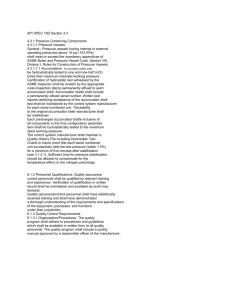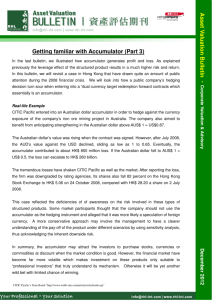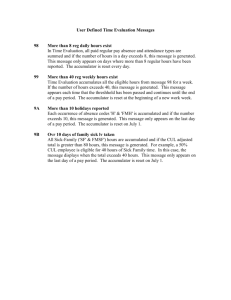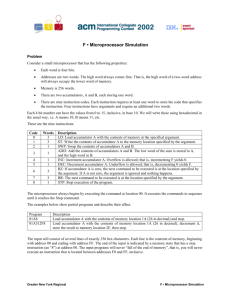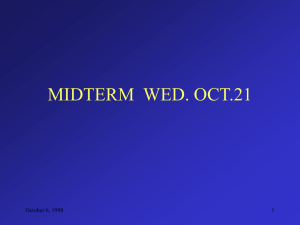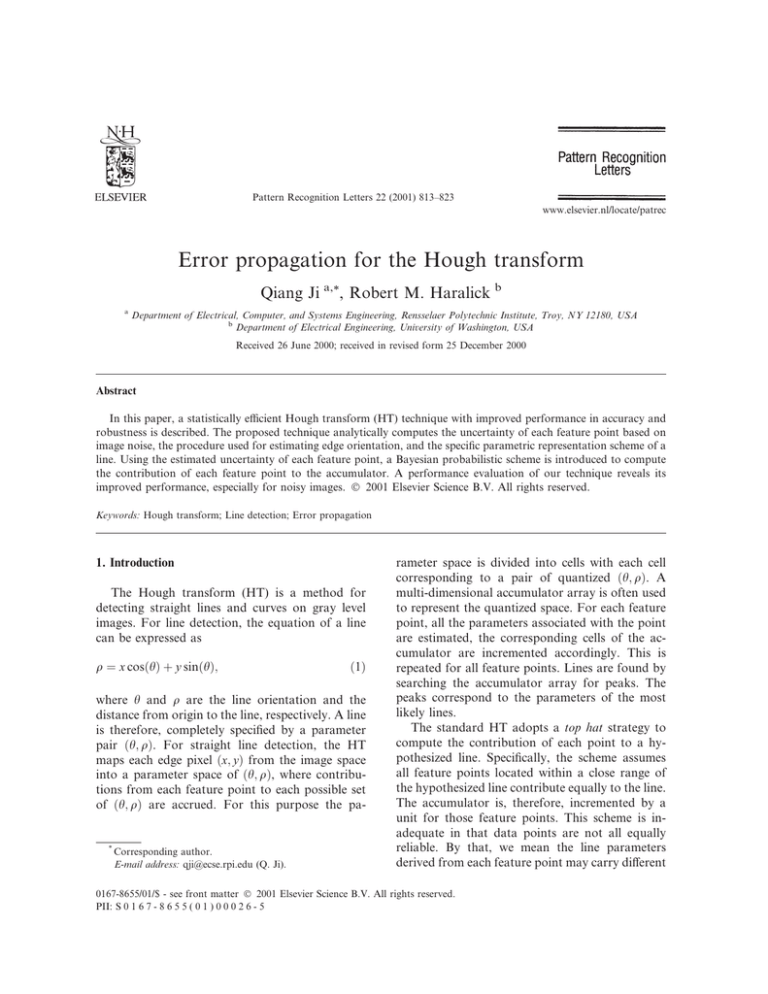
Pattern Recognition Letters 22 (2001) 813±823
www.elsevier.nl/locate/patrec
Error propagation for the Hough transform
Qiang Ji a,*, Robert M. Haralick b
a
Department of Electrical, Computer, and Systems Engineering, Rensselaer Polytechnic Institute, Troy, NY 12180, USA
b
Department of Electrical Engineering, University of Washington, USA
Received 26 June 2000; received in revised form 25 December 2000
Abstract
In this paper, a statistically ecient Hough transform (HT) technique with improved performance in accuracy and
robustness is described. The proposed technique analytically computes the uncertainty of each feature point based on
image noise, the procedure used for estimating edge orientation, and the speci®c parametric representation scheme of a
line. Using the estimated uncertainty of each feature point, a Bayesian probabilistic scheme is introduced to compute
the contribution of each feature point to the accumulator. A performance evaluation of our technique reveals its
improved performance, especially for noisy images. Ó 2001 Elsevier Science B.V. All rights reserved.
Keywords: Hough transform; Line detection; Error propagation
1. Introduction
The Hough transform (HT) is a method for
detecting straight lines and curves on gray level
images. For line detection, the equation of a line
can be expressed as
q x cos
h y sin
h;
1
where h and q are the line orientation and the
distance from origin to the line, respectively. A line
is therefore, completely speci®ed by a parameter
pair
h; q. For straight line detection, the HT
maps each edge pixel
x; y from the image space
into a parameter space of
h; q, where contributions from each feature point to each possible set
of
h; q are accrued. For this purpose the pa*
Corresponding author.
E-mail address: qji@ecse.rpi.edu (Q. Ji).
rameter space is divided into cells with each cell
corresponding to a pair of quantized
h; q. A
multi-dimensional accumulator array is often used
to represent the quantized space. For each feature
point, all the parameters associated with the point
are estimated, the corresponding cells of the accumulator are incremented accordingly. This is
repeated for all feature points. Lines are found by
searching the accumulator array for peaks. The
peaks correspond to the parameters of the most
likely lines.
The standard HT adopts a top hat strategy to
compute the contribution of each point to a hypothesized line. Speci®cally, the scheme assumes
all feature points located within a close range of
the hypothesized line contribute equally to the line.
The accumulator is, therefore, incremented by a
unit for those feature points. This scheme is inadequate in that data points are not all equally
reliable. By that, we mean the line parameters
derived from each feature point may carry dierent
0167-8655/01/$ - see front matter Ó 2001 Elsevier Science B.V. All rights reserved.
PII: S 0 1 6 7 - 8 6 5 5 ( 0 1 ) 0 0 0 2 6 - 5
814
Q. Ji, R.M. Haralick / Pattern Recognition Letters 22 (2001) 813±823
uncertainties due to the following reasons. Most
HT techniques employ certain techniques for estimating the orientation of feature points (edgels)
to restrict the ranges of values of h a pixel may
vote for. The estimation of the orientation of each
edge pixel is often uncertain due to: (1) image noise
(e.g., positional errors from quantization and
sensor errors); (2) small neighborhood associated
with the edge detection procedure and the inherent
uncertainty with the procedure; (3) the parametric
representation used to de®ne a line (e.g., Eq. (1)).
Feature points, therefore, vary in uncertainties.
They should not be treated equally.
In this paper, we propose to investigate the ef®cacy of a probabilistic scheme for computing the
contribution of each feature point to the accumulator array. Our scheme analytically estimates
the uncertainty of the line parameters derived from
each feature point, based on which a Bayesian
accumulator updating scheme is proposed to
compute the contribution of the point to the accumulator.
The proposed scheme is based on the following
observation. At each edge pixel (x; y), its direction
h is ®rst estimated based on the gradient information. The random perturbation on the input
^ the estimate of h. The
image data propagates to h,
amount of uncertainty with h^ not only depends on
image error but also on the procedure used to es^ Subsequently, when q is computed based
timate h.
^
on h using Eq. (1), the perturbation on h^ propagates to q^, the estimate of q. The contribution of
^ q^, therefore depoint
x; y to parameter set
h;
^ q^.
pends on the uncertainty associated with
h;
We propose to analytically estimate the uncertainty of each point and update the accumulator
array accordingly based on the estimated uncertainty.
In the sections to follow, we detail the scheme
and study its performance. Section 2 brie¯y discusses previous eorts in this area. The proposed
scheme is covered in Section 3, where we analytically derive the error propagation scheme and the
Bayesian accumulator updating scheme. Section 4
presents the results of a performance analysis of
the improved HT against the standard HT transform. This paper ends in Section 5 with a discussion of the proposed scheme.
2. Previous work
Previous eorts in algorithmic improvement to
HT focused on improving the computational eciency of the HT (speed and memory). Early efforts in this aspect concentrated on reducing the
number of bins used for tessellating the parameter
space. Many proposed techniques drew on some
form of coarse-to-®ne search strategy resulting in a
dramatic reduction of cells.
More recent eorts have been focusing on
sampling the feature points. The idea is to use only
a subset of image features. These eorts give rise to
dierent probabilistic (also called randomized) HT
techniques (Davies, 1986; Xu et al., 1990; Xu and
Oja, 1993; Kiryati et al., 1991; Kalviainen et al.,
1994; Galmbos et al., 1999), which increase the
computational eciency and decrease memory
usage by means of sampling the image feature
space.
Recently, Kittler and Pamler (1994) argued that
research eorts should focus on addressing the issues of performance quality (accuracy) instead of
on computational aspects. They believe that improvements in computer hardware automatically
speed up algorithms, and that memory chips are
becoming increasingly cheaper. We agree with
their opinion. The emphasis of this research is
therefore, on improving the robustness and accuracy of the HT techniques.
Researchers have long realized the limitation
of the standard HT scheme and have proposed
dierent schemes to improve the performance of
HT. O'Gorman and Clowes (1976) ®rst suggested
the accumulator be increment by the magnitude
of the gradient of each edge pixel. Their motivation is to weight the contribution of each edge
pixel to the accumulator such that the pixels at
which h can be more accurately estimated contribute more to the accumulator. Other authors
including Ballard (1981), Thrift and Dunn (1983),
Veen and Groen (1991) suggest using weighting
factors to weigh each feature point so that the
most prominent or the most certain image features contribute more to accumulator cells than
less certain data. Most of these schemes usually
are variants of that of O'Gorman's, i.e., the
weighting factors are derived from edge gradient
Q. Ji, R.M. Haralick / Pattern Recognition Letters 22 (2001) 813±823
measurements. They are either ad hoc or heuristic, involving little theoretical justi®cation. They
ignored the uncertainties associated with the estimated q parameter. Furthermore, they tend to
ignore the uncertainties introduced by the speci®c
line parameter representation. As we will see, the
uncertainties with q not only relate to gradient
information but also relate to point location and
line orientation. Thrift and Dunn (1983) proposed to use a heuristic function, called an in¯uence function, to determine the contribution of
each cell to the accumulator. The method was
reported to be superior to the standard HT on
noise perturbed examples of simple shapes. Haralick and Shapiro (1992) proposed a Bayesian
approach to increment the accumulator based on
the joint probability of h and q, but did not
elaborate on how the joint probability can be
estimated.
Kittler and Pamler (1994) described a statistical
hypothesis testing approach for the HT. The proposed technique replaces the commonly used tophat kernel with a smooth kernel. For each feature
point, its contribution to the accumulator array at
a hypothesized cell
h; q is computed from the
smooth kernel function, which is a function of the
dierences between the estimated model parameters and hypothesized model parameters.
Though very similar to our approach in spirit,
they proposed a rather complex and computationally intensive scheme to derive an optimal
analytic form of the kernel function. The kernel
function is analytically determined by maximizing
the power function, the probability of rejecting the
incorrect hypothesis.
Stephens' (1991) work is very much similar to
ours. Both methods update the accumulator array
probabilistically. The major dierence between
ours and Stephens' lies in the probability used to
update the accumulator. Through error propagation, we propagate the perturbation with each
point to the computed curve parameter and update
the true (quantized) curve parameter by its likelihood, assuming the computed curve parameter is
Gaussian distributed with each quantized curve
parameter as its mean and its perturbation (estimated via error propagation) as its covariance
matrix. Stephens', on the other hand, only updates
815
the computed curve parameter based on its likelihood given a point. It has the following drawbacks: (1) only the computed curve parameters are
updated and others are not; (2) it is dicult to
model the probability density function (pdf) between an image point and the estimated curve
parameters. The proposed pdf model may be
suitable for modeling the pdf of an image point
with the ideal curve parameters. The two methods
also dier in modeling perturbations with the image points. We model both intensity and positional
errors while Stephens' only models positional error. Finally, Stephens did not mention for real
images how to estimate the required positional and
orientational errors.
3. Overview of the proposed scheme
We follow most HT techniques, i.e., starting
with estimating h for each pixel using directional
intensity gradient measurements and then, computing q using Eq. (1). This can be used to restrict the range of values of h that the pixel may
vote for. It permits one-to-many mapping to be
restricted to one-to-few mapping of image point
to a parameter point. We assume that the gradient at a particular pixel is estimated by computing an equally weighted least squares ®t to the
gray levels in the pixel's neighborhood. It is also
assumed that the input image is corrupted with
additive Gaussian noise with zero mean and
variance r2 . In the following sections, we will
show how to estimate h for each pixel, compute
its perturbation r2h , and analytically propagate
this propagation to q.
3.1. Uncertainty of the estimated line parameters
^ q^ be a vector representing the es^
h;
Let H
timated line parameters for a feature point. The
uncertainty of the estimated line parameters can be
^
characterized by RH^ , the covariance matrix of H.
RH^ can be analytically expressed as
2
rh rhq
RH^
;
2
rhq r2q
816
Q. Ji, R.M. Haralick / Pattern Recognition Letters 22 (2001) 813±823
where r2h and r2q represent the variances of the
estimated line orientation and position parame^
ters, and rhq the covariance of q^ and h.
In the paragraphs to follow, we will show, how
to analytically compute r2h , r2q and rqh , respectively.
3.1.1. Estimation of h and its perturbation
If we approximate the image gray-tone values in
pixel (x; y)'s neighborhood by a facet plane
ay bx c (Haralick, 1980), then the estimated
gradient direction h^ for (x; y) is
a^
tan h^ ;
b^
3
where a^ and b^ are estimates of a and b, resulting
from a least-squares ®tting. Taking a Taylor
expansion of the right-hand side of Eq. (3)
around
a; b, we obtain to a ®rst order approximation
1
D tan h Da
b
a
Db:
b2
4
Similarly, expanding the left-hand side of Eq. (3)
around h, we obtain
D tan h
Dh
:
cos2 h
5
Combining Eqs. (4) and (5) yields
Dh
1
Da
b
a
Db cos2 h:
b2
6
^ r2 , is
As a result, the perturbation of h,
h
r2h
r2a a2 r2b
4
b2
b
2a
rab
b3
!
cos4 h;
7
where a, b, r2a , r2b , and rab are estimated as follows
(Haralick, 1980). Let R be the rectangular region
that we use to estimate a and b. Let the row index
of R be Y and column index be X. And let g
x; y)
be the intensity at location (x; y). Then, we have
x; y 2 X Y .
P
a^
b^
P
y2Y
x2X
P
P
x2X
P
P
y2Y
x2X
8
yg
x; y
;
2
y2Y y
9
;
10
;
11
P
P
x2X
r2a P
xg
x; y
;
2
y2Y x
r2
P
y2Y
r2b P
x2X
r2
P
y2Y
rab P
y2Y
x2X
x2
y2
P
P
r2 y2Y
xy
P
P x2X P
;
2
2
x2X x
y2Y
x2X y
12
P
P
P
P
2
2
2
where r2 =
y2Y
x2X y and r =
y2Y
x2X x
is the summation of the squared row (column)
index values over the neighborhood used in the
least-square ®t. For a rectangular neighborhood,
r2a r2b . For a symmetric neighborhood
that is,
P R,P
if x 2 R implies x 2 R, we have,
y2Y
x2X xy
0, i.e., rab 0.
We must emphasize two things. First, Eq. (7)
only approximates variance of h^ estimated from
the linear facet-®tting procedure. For h^ estimated
from dierent procedures like Sobel or Canny,
Eq. (7) is not applicable. This, however, does not
mean we cannot propagate error for other edge
detectors. In fact, for any edge detectors with a
given kernel, we can analytically compute the uncertainties associated with the computed ®rst order
directional gradients (e.g., Ix and Iy ) (Ji and Haralick, 1999a). Substituting a and b in equation
with Ix and Iy in Eq. (3), we can proceed in the
same fashion to compute r2h and r2q . Second, r2h
only characterizes the random uncertainties of
h^ due to image noise r2 . It does not account for
any systematic errors inherent with the procedure
used for estimating h.
3.1.2. Estimating r2q , the uncertainty of the estimated line parameter q
For each observed pixel
x; y, given h^ its q^ is
estimated via
^
q^ x cos h^ y sin h:
13
Taking a Taylor expansion of Eq. (13) around h; x
and y, we obtain to a ®rst order approximation:
Q. Ji, R.M. Haralick / Pattern Recognition Letters 22 (2001) 813±823
Dq cos hDx sin hDy
y cos h
x sin hDh:
14
The variance of q^ is therefore,
r2q cos2 hr2x sin2 hr2y
y cos h
x sin h2 r2h ;
15
where r2x , r2y and r2h are standard deviations for
positional and orientational errors. If we assume
r2x r2y r2p , Eq. (15) becomes
r2q r2p
y cos h
x sin h2 r2h :
If we let
k y cos h
x sin h:
Then the variance of q^ is
r2q k 2 r2h r2p :
By substituting Eq. (7) into (16), we have
!
r2a a2 r2b 2a
2
2
rq k
4
rab cos4 h r2p
b2
b
b2
16
17
where a, b, r2a , and r2b can be estimated from
Eqs. (8)±(12), respectively. Geometrically, k can
be interpreted as the distance from an image
point
x; y to the point closest to the origin on
the line determined by
h; q as shown in Fig. 1.
So r2q not only depends on r2h but also on the
geometric location of the point via k as well as
line orientation. As k increases or h decreases, r2q
817
increases. It is also clear from Eq. (17) that r2q is a
function of: (1) image intensity perturbation via
r2a , r2b , and rab ; (2) point location via k; (3) positional error via r2p .
Eq. (17) is signi®cant in that it reveals that the
variance of the estimated line parameter q^ not only
relates to the input perturbation via perturbation
on h as expected, but also relates to the distance of
the feature point to the origin (or the location of
the point), as well as to the orientation of the line.
It implies that a point further from the origin may
induce more uncertainty and that lines with larger
angles can be more accurately estimated than
those with smaller angles. Given equal position, r2q
is 0 for horizontal lines and is maximum for vertical lines. This echoes the conclusion drawn by
Davies (1986), who showed that the parameter
error increases as the distance from the foot of the
normal to the origin increases. He recommended
to change origins in order to derive more accurate
parameter estimation.
This means that the uncertainty of a feature
point depends on the HT coordinate system employed and that we can always translate and rotate
the coordinate system to minimize r2q . Based on the
above analysis, we can conclude that the quality of
the estimated line parameters can always be improved by simply selecting the appropriate coordinate system. A coordinate system centered at the
centroid of the feature points should always yield
better quality of the estimated line parameters than
a coordinate system centered at one of the corners
since it leads to smaller k value for each point.
Using Eq. (14), rqh , the covariance of q^ and h^
can be computed as follows.
rqh E
DhDq
2
E
Dh
y cos h
x sin h
EDxDh EDyDh
kr2h ;
18
where we assume Dh is uncorrelated to Dx and Dy.
3.2. Estimating image error r2
Fig. 1. Geometric interpretation of k.
Computation of the r2h , r2q , and rhq requires r2 ,
the amount of perturbation associated with image
^ y be the observed gray-tone
intensities. Let I
x;
818
Q. Ji, R.M. Haralick / Pattern Recognition Letters 22 (2001) 813±823
value for pixel located at
x; y. If we approximate
the image gray-tone values in pixel
x; y's neighborhood by a plane ay bx c, then the image
perturbation model can be described as
^ y ay bx c n;
I
x;
where n represents the image intensity error and
follows an iid distribution with n N
0; r2 .
For a M N neighborhood, the sum of squared
residual ®tting errors
2
N X
M
X
^ y
I
x;
ax
by
2
c ;
is distributed r2 2 v2MN 2 . As a result, we can
obtain r^2 , an estimate of r2 , as follows
2
M N
2
:
Assume each pixel is perturbed identically and
independently with the same variance r2 , we can
obtain a more accurate estimate of r2 by averaging
r^2 obtained from each neighborhood over the entire image.
Let r^2k be an estimate of r2 from the kth
neighborhood. Given a total of K neighborhoods
across the image, we can obtain
r^2
^
H
H R
x;y2X Y P
H j H;
K
1 X
r^2 :
K k1 k
20
^ is a
where X Y is the image domain, note H
function of image point
x; y. If, however, the
prior for H is not available, we may assume uniform prior for H, then H
h; q can be incremented
by the sum of its likelihoods at each point, i.e.,
^ j H
H
H R
x;y2X Y P
H
y1 x1
r^2
^ the sum of posterior
be incremented by P
H j H,
^ at each image point
probability of H given H
x; y, i.e.,
21
^
Given each image point, we can obtain an H,
^
whose support for H is quanti®ed by P
HjH. The
total support for a particular quantized value H is
the sum of all supports it receives from each every
feature point.
^ q^
It is clear from Eq. (21) that given each
h;
and its covariance matrix RH^ , the bin for a
h; q is
^ j H, the likelihood of H
updated based on P
H
^
given the observed H. The further away H is from
^ the smaller the likelihood is and the less conH,
tribution H
h; q receives from the point
x; y
as shown in Fig. 2, which graphically illustrates the
^ j H given H
^ and R ^ . The
density function of P
H
R
probabilistic updating scheme introduced here
diers from the standard HT and other techniques
^ updated but other Hs
in that, not only is H H
4. Increment the accumulator
Given RH^ , we propose a Bayesian scheme to
probabilistically compute the contribution of each
feature point to the accumulator array. Assume
^ q^, a line parameter vector estimated from
^
h;
H
^ N
H; R ^ ,
a feature point, is distributed as H
H
where H
h; q is a vector consisting of all pos^ the
sible quantized values of h and q. Given H,
^
likelihood of H can be computed as P
HjH
^ j H
2p 1 jR ^ j
P
H
H
1=2
exp
^ Ht R 1
H
^ H
1=2
H
^
H
:
19
If the prior information about H is available, then
accumulator H
h; q for parameter H
h; q can
Fig. 2. Illustration of the procedure for probabilistically updating the accumulator array in the Hough space, where
^ j H is the likeliH
h; q is a quantized parameter and P
H
^ q^. H
^
h;
^ is obtained from a feature point
hood of H given H
using Eq. (1).
Q. Ji, R.M. Haralick / Pattern Recognition Letters 22 (2001) 813±823
nearby are also updated in a statistically optimal
fashion.
The smooth kernel function as represented by
^ j H is in ®rm contrast with the top-hat kernel
P
H
employed by most HT techniques. While similar to
the one proposed by Kittler and Pamler (1994),
ours can be derived more eciently.
^ and its covariance matrix
In practice, given H
RH^ , a 1r-limit elliptical region can be established in
h q space (the shaded region shown in Fig. 3)
such that bins for Hs located within the shaded
region are updated accordingly using Eq. (21)
while bins for Hs located outside the region are not
updated since their probabilities are negligible.
The major and minor axes of the elliptical region
are the two eigenvectors of RH^ .
819
5. Performance characterization
In this section, we present sample results on a
variety of images to highlight the improvements in
detection accuracy and robustness that can be obtained from the proposed scheme. The performance of the proposed scheme (referred to as
improved HT hereafter) was evaluated against the
standard HT on a synthetic image. Finally, the
performance of the improved HT is further assessed using real images. The synthetic image
contains a set of line segments in dierent directions as shown in Fig. 4. We are interested in
comparing the results of the two methods by applying them to images corrupted with varying
amount noises. The noisy images result from corrupting the intensities of original images by adding
Gaussian noise with a mean of zero and a variance
of r2 to each pixel independently. Three dierent
values of r2 was used to perturb the original image.
The edge points were extracted using a 3 3 facet
model. The performance of a HT was evaluated by
visually inspecting the 3D accumulator plots to see
if distinct peaks can be recognized. These peaks
correspond to the line segments in the image.
5.1. Experimental results
Fig. 3. An elliptical region for probabilistically updating the
accumulator array in the Hough space.
The ®rst part of the experiment involves 3D
accumulator plots comparison. The accumulator
array obtained using the standard and improved
HT on perfect images are plotted in Figs. 5(a) and
(b), respectively. The two images look very much
identical (though the peaks in (b) are more
Fig. 4. The synthetic test image containing eight lines segments: (a) the original image; (b) image after perturbing (a) with r 5;
(c) image after perturbing (a) with r 10; (d) image after perturbing (a) with r 20.
820
Q. Ji, R.M. Haralick / Pattern Recognition Letters 22 (2001) 813±823
Fig. 5. 3D accumulator plots obtained using the standard HT (a) and the improved HT (b) from the perfect image. The eight peaks
correspond to the eight line segments in the image.
distinctive). This is correct since when r2 0, we
can see from Eq. (17), the variance of q is zero.
The improved scheme is therefore the same as the
standard HT. Figs. 6±8 show the accumulator arrays obtained using the improved HT and standard HT, respectively on noisy images, with
r2 5, 10 and 20, respectively. From these ®gures,
we can see as the noise level increases, the per-
formance of standard HT degenerates very quickly
as shown by the larger blurred peak clusters, a
reduction in the number of peaks observable, and
an increase in the number spurious peaks. For
example, when r2 10, only three peaks can be
recognized from Fig. 7(a) and there are several
false peaks near 0°, 315° and 360°. The problem
is more evident in Fig. 8(a), with a signi®cant
Fig. 6. 3D accumulator plots obtained using the standard HT (a) and the improved HT (b) from the image corrupted with noise level
of r 5.
Fig. 7. 3D accumulator plots obtained using the standard HT (a) and the improved HT (b) from the image corrupted with noise level
of r 10.
Q. Ji, R.M. Haralick / Pattern Recognition Letters 22 (2001) 813±823
821
Fig. 8. 3D accumulator plots obtained using the standard HT (a) and the improved HT (b) from the image corrupted with noise level
of r 20.
increase in spurious peaks and resulting in a loss of
half of the line segments and peaks become even
more indistinguishable. In contrast, for the improved HT, the eect of additional noise is not as
much serious as shown in Figs. 7(b) and 8(b).
Similar results were obtained when using other
synthetic images. To test our technique with real
images, we applied it to images parts. Sample results are shown in Figs. 9 and 10.
6. Discussion and future work
In this paper, we introduce a Bayesian updating
scheme that systematically ties the uncertainties
computed for each point to its contribution. The
contribution of each point to a
h; q is proportional to its likelihood. The proposed scheme is
based on an analytical propagation of input errors.
It results from theoretical and statistical derivations and therefore, possesses a great statistical
eciency.
Our study shows that the uncertainty of a feature point depends on: (1) the input perturbation;
(2) its relative spatial location to the Hough coordinate system; (3) edge detector; (4) line representation scheme. We can always manipulate the
HT coordinate system to reduce the uncertainty
with each feature point, therefore, improving the
quality of the estimated line parameters. This implies that a HT coordinate system centered at the
centroid of the image feature should yield better
line parameter estimates than a coordinate system
centered at one of the corners.
The preliminary results from the performance
characterization of the proposed scheme on
Fig. 9. Examples of detected lines for two real images. Detected lines are superimposed on the original images.
822
Q. Ji, R.M. Haralick / Pattern Recognition Letters 22 (2001) 813±823
Fig. 10. Examples of detected lines for two additional images. Detected lines are superimposed on the original images.
synthetic images revealed that the proposed
scheme is superior to the standard HT in that it
can yield a better accumulator with less irrelevant
data and more prominent peaks, especially in
noisy images. The study also shows that the improved HT is more robust and accurate to noise
and yields good results with real images.
A further advantage of the proposed method is
that it quanti®es the uncertainties associated with
the estimated line parameters. This valuable information can be subsequently exploited by the
higher vision tasks to characterize the accuracy of
its output.
One disadvantage of the proposed scheme as
compared to the standard HT is that it is computationally more involved. This problem will
become less an issue with the advent of the new
computer hardware. Another disadvantage of
our approach is that it ties to the technique used
for estimating edge orientation. For a dierent
edge-orientation technique, the error propagation
procedure needs to be re-derived to compute the
variance of the estimated edge orientation.
However, basic theory for error propagation with
most edge detectors like Canny and Sobel can be
derived in a similar fashion. Furthermore, error
propagation from h to q and the Bayesian
scheme for incrementing the accumulator remain
the same. Another potential disadvantage with
our approach as with any HT that makes use of
the edgel orientation computed from an edge
detector, the systematic positional error (bias)
associated with the estimated edgel orientation is
not accounted for. Our approach implicitly assumes small systematic positional error. The
systematic positional error could be large for
certain edge detectors operating with small convolution kernel. We only consider random positional error.
One of the future tasks is to conduct experiments to compare the proposed scheme with other
methods, especially the one proposed by Kittler
and Pamler (1994). From Eq. (17), we can see r2q
depends on k. Minimizing k can therefore, reduce
the uncertainties associated with each edge point.
For a given image, k can be minimized by selecting
the origin of HT coordinate at the centroid of the
objects of interests (here are linear features). As a
result, another possible future work is to verify the
impact of dierent HT coordinate systems on HT
performance including accuracy and computational complexity.
The error propagation scheme discussed in this
paper is only intended for least-square line ®tting.
We have, however, extended (Ji and Haralick,
1999b) this scheme to allow analytical error
propagation for general curve-®tting problems
including circles and ellipses. Given the covariance
matrix characterizing the error of the estimated
curve parameters, the Bayesian accumulator updating scheme introduced in this paper can be directly applied. We can therefore, conclude that the
extended error propagation scheme can be used
with the HT for detecting any curves.
Q. Ji, R.M. Haralick / Pattern Recognition Letters 22 (2001) 813±823
References
Ballard, D.H., 1981. Generalizing the Hough transform to
detect arbitrary shapes. Pattern Recognition 13, 111±122.
Davies, E.R., 1986. Image space transforms for detecting
straight edges in industrial images. Pattern Recognition
Lett. 4, 185.
Galmbos, C., Matas, J., Kittler, J., 1999. Progressive probabilistic Hough transform for line detection. In: 1999 IEEE
Comput. Soc. Conf. Comput. Vision Pattern Recognition,
pp. 554±560.
Haralick, R.M., 1980. Edge and region analysis for digital
image data. CGIP 12, 60.
Haralick, R.M., Shapiro, L.G., 1992. Computer and Robot
Vision. Vol. 1, Addison-Wesley, Reading, MA, p. 585.
Ji, Q., Haralick, R., 1999a. Quantitative evaluation of edge
detectors using the minimum kernel variance criterion. In:
IEEE Internat. Conf. Image Processing, Kobe, Japan,
October, pp. 705±709.
Ji, Q., Haralick, R.M., 1999b. Error propagation for computer
vision performance characterization. In: Internat. Conf.
Imaging Science, Systems, and Technology, Las Vegas,
June, pp. 429±435.
Kalviainen, H., Hirvonen, P., Xu, L., Oja, E., 1994. Comparisons of probabilistic and non-probabilistic Hough trans-
823
forms. In: Proc. 3rd European Conf. Comput. Vision, 2±6
May, 1994, p. 801.
Kiryati, N., Eldar, Y., Bruckstein, A.M., 1991. Probabilistic
Hough transform. Pattern Recognition Lett. 24 (4), 303±
316.
Kittler, J., Pamler, P.L., 1994. Robust and statistically ecient
detection of parametric curves in 2d images. NSF/ARPA
Workshop on Performance and Methodology in Computer
Vision, Seattle.
O'Gorman, F., Clowes, M.B., 1976. Finding picture edges
through collinearity of feature points. IEEE Trans. Comput. C-25 (4), 449.
Stephens, R.S., 1991. Probabilistic approach to the Hough
transform. Image Vision Comput. 9 (1), 66±71.
Thrift, P.R., Dunn, S.M., 1983. Approximating point-set
images by line segments using a variation of the Hough
transform. Comput. Vision Graphics Image 21, 383.
Veen, T.M., Groen, F.C., 1991. Discretization errors in the
Hough transform. Pattern Recognition 14 (1±6), 137.
Xu, L., Oja, E., 1993. Randomized Hough transform: basic
mechanisms, algorithms, and computational complexities.
CVGIP: Image Understanding 57 (2), 131±154.
Xu, L., Oja, E., Kultanen, P., 1990. A new curve detection
method: randomized Hough transform (rht). Pattern Recognition Lett. 11 (5), 331±338.

